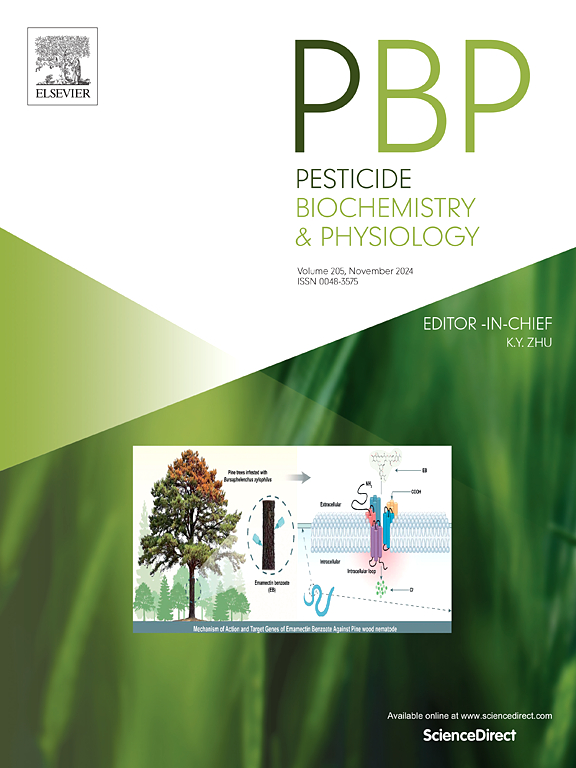Insecticidal activity of two Pelargonium essential oils and head transcriptome analysis of stored-product pest Tribolium castaneum (Herbst) (Coleoptera: Tenebrionidae) in response to citronellyl formate fumigation
IF 4.2
1区 农林科学
Q2 BIOCHEMISTRY & MOLECULAR BIOLOGY
引用次数: 0
Abstract
Tribolium castaneum (Herbst) is one of the most common stored-product pests, causing enormous economic losses and developing widespread resistance to chemical insecticides. Natural products derived from essential oils (EOs) are well-known for insecticidal activity against agricultural pests, especially in the management of stored-product pests. In this study, the chemical constituents and repellent, contact and fumigation toxicity activities of two Pelargonium EOs against T. castaneum were evaluated. Moreover, the fumigation mechanism of citronellyl formate was assessed by head transcriptome sequencing and RNA interference (RNAi). A total of 28 and 39 compounds were identified by gas chromatography-mass spectrometry, accounting for 98.58 and 97.33 % of P. roseum and P. asperum EOs, and the major components were citronellol, (1S)-(1)-β-pinene and citronellyl formate. (1S)-(1)-β-Pinene exhibited strong contact toxicity activity (LD50 = 19.72 μg/adult), while citronellyl formate exhibited strong repellent and fumigation toxicity activities, with the LC50 value of 11.93 mg/L air. Under the stress of citronellyl formate, 1222 differentially expressed genes were identified, including 554 up-regulated and 668 down-regulated genes, which was further verified by qRT-PCR. Among odorant-binding proteins (OBPs), only TcGOBP70 was up-regulated, suggesting that GOBP70 is more likely to be involved in the defense of T. castaneum by recognizing, binding and transporting citronellyl formate. Additionally, RNAi against TcGOBP70 dramatically increased the contact and fumigation toxicity activities of citronellyl formate, with mortality rates of 73 and 75 %, respectively. Therefore, our findings not only provided theoretical bases for the comprehensive utilization of the Pelargonium species but also established potential targets for controlling T. castaneum adults.

求助全文
约1分钟内获得全文
求助全文
来源期刊
CiteScore
7.00
自引率
8.50%
发文量
238
审稿时长
4.2 months
期刊介绍:
Pesticide Biochemistry and Physiology publishes original scientific articles pertaining to the mode of action of plant protection agents such as insecticides, fungicides, herbicides, and similar compounds, including nonlethal pest control agents, biosynthesis of pheromones, hormones, and plant resistance agents. Manuscripts may include a biochemical, physiological, or molecular study for an understanding of comparative toxicology or selective toxicity of both target and nontarget organisms. Particular interest will be given to studies on the molecular biology of pest control, toxicology, and pesticide resistance.
Research Areas Emphasized Include the Biochemistry and Physiology of:
• Comparative toxicity
• Mode of action
• Pathophysiology
• Plant growth regulators
• Resistance
• Other effects of pesticides on both parasites and hosts.

 求助内容:
求助内容: 应助结果提醒方式:
应助结果提醒方式:


